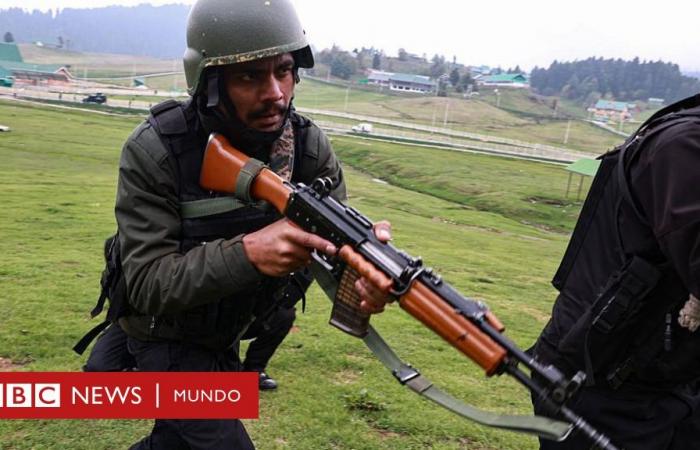
Image source, Getty Images
- Author, Redacción*
- Author’s title, BBC News world
-
29 minutes
India and Pakistan are going through the worst burst of violence in two decades.
The Indian Army launched an attack with missiles against Pakistan and the Kashmir administered by Islamabad in which it claims to have attacked nine spotlights of “terrorist hiding places.”
Pakistan affirms that there were six places attacked and that he managed to demolish five Indian combat planes, information that New Delhi has not confirmed.
This new climbing is the most recent episode of a long conflict that has gained thousands of fatal victims and whose roots extend for more than seven decades.
Both India and Pakistan claim Kashmir in their entirety.
After the attack, Pakistan has accused India of committing a “flagrant act of war” and promised reprisals.
Experts in the Indian subcontinent do not rule out the possibility that India will throw a limited military action that could lead to a total war in the region.
HS Panag, a Lieutenant General retired from the Indian Army, warned that his country should not make a hurried decision.
In an article on the Indian digital platform The Printrecalled that Pakistan is a country with nuclear weapons and has enough conventional power to respond strongly to an Indian military action.
“India does not have enough technological advantage in any area, or in missiles, drones or air force, to carry out a retaliation attack without suffering losses. Pakistan has the ability to respond and we must be prepared,” he wrote.
On the other hand, in a recent interview with the BBC, Pakistan’s defense minister Khawaja Asif said that his country was prepared for any scenario.
“We don’t have to prepare. We have already prepared. We are ready for any situation,” he said.
On Saturday, Pakistan’s prime minister Shahbaz Sharif also said: “If you take some type of adventurous action, an answer will be given as in 2019”.
He was referring to the response given by Islamabad when he demolished two combat aircraft of the Indian Air Force, in a series of clashes between the two countries, after an attack occurred in pulwama, in the Cashmira area controlled by India, in which at least 40 Indian paramilitaries died in a suicidal attack with auto bomb.
But how are the military capacities of both countries compare?
The Force of the Indian Army
Image source, Getty Images
According to Global Fire Power, there is a gap of eight positions between India and Pakistan in the ranking of countries with greater military force in 2025.
India occupies fourth place among 145 countries, while Pakistan is in 12th place.
The Indian army is one of the largest in the world, with around 2.2 million military troops.
It has 4.201 tanks, around 1.5 million armored vehicles, 100 pieces of self -propelled artillery and 3,975 towed artillery.
It also has 264 multicañón rocket launches.
The Indian Air Force has just over 300,000 troops and a total of 2,229 aircraft, including 513 combat planes and 270 transport aircraft.
The total fleet of aircraft includes 130 attack, 351 training and six refueling.
The total number of helicopters that have the three wings of the Indian army is 899, of which 80 are attack helicopters.
For its part, the Indian Navy has 142,000 troops and a total of 293 ships, including two aircraft carriers, 13 destroyers, 14 frigates, 18 submarines and 18 corvettes.
In terms of logistics, the Indian Army counts at its disposal of 311 airports, 56 ports and 65,000 kilometers of rail lines.
The Force of the Pakistan Army
Image source, Getty Images
According to Global Fire Power, the Pakistani army has around 1,311,000 military personnel, 124,000 naval troops and 78 thousand members of the Air Force.
Pakistan has a total of 1,399 aircraft, including 328 combat, 90 attack, 64 Transportation, 565 training.
In addition, it has four fleets of tank aircraft and 373 helicopters, including 57 attack.
It has 2,627 tanks, 17,516 armored vehicles, 662 pieces of self -propelled artillery, 2,629 of towed artillery and 600 of multicañón cohetera artillery.
For its part, the Pakistan Navy has a total of 121 warships, including 9 frigates, 9 corvettes, eight submarines and 69 patrol ships.
In logistics terms, it has 116 airports, three ports and 11,900 kilometers of railways.
Nuclear weapons
According to a 2024 report published by the International Institute for Peace Research in Stockholm (SIPRI), a study center specialized in the study of military spending and arms trade in the world, India has 172 nuclear eyes, while Pakistan is 170.
However, it is not known how many nuclear weapons are deployed in both countries.
The Sipri states that Pakistan is preparing nuclear weapons for a possible war with India, while New Delhi has focused more on the deployment of long -range weapons.
Such weapons could also aim China.
China, a neighboring country of India and Pakistan and the third largest nuclear power in the world, has increased its number of nuclear weapons by 22%, from 410 eyelets to 500.
Drones
Image source, Getty Images
Shakeel Akhtar, journalist of the URDU service of the BBC, says that both India and Pakistan have been expanding in recent years their arsenals of military drones.
The expert detailed in an article published last November that both countries have not only bought many foreign drones, but have also developed their own technology to monitor, spy and attack objectives without pilots.
For his part, defense analyst Rahul Bedi estimates that India will have 5,000 drones in the next two to four years.
According to him, Pakistan has “less drones than India”, but the devices he possesses have different abilities and are between 10 and 11 different brands.
In October last year, India signed an agreement with the United States to buy 31 predator drones for a value of US $ 3.5 billion.
Predator drones are considered the most successful and dangerous in the world.
Likewise, they have bought bombs and missiles that can be guided by laser for a value of US $ 500 million. These weapons can be used to destroy goals through drones.
According to Rahul Bedi, Pakistan imports drones mostly from Türkiye and China, but has also bought German and Italian drones.
Islamabad has also developed its own drones such as Barraq and Shahpar.
Antibalistic missile system
Image source, Getty Images
“India is one of the few countries that has an antibalistic missile system,” writes defense analyst Harrison Cass on the website The National Interest.
India has two types of missiles in its antimile defense system.
The first is the Pithvi, which intercepts attacks with great altitude missiles, and the second is the Advanced Air Defense System (AAD), also known as Ashwin Balistic Missile Interceptor, which intercepts attacks with missiles at low altitude missiles.
It is expected that the Indian antibalistic missile system will be able to intercept missile attacks from a distance of at least 5,000 kilometers.
New Delhi has also developed the brahmos and brahmos-2 hypersonic cruise missiles in collaboration with Russia, which can be launched from land, aerial, maritime and underwater platforms.
“India has numerous conventional and nuclear missile options. It also has the ability to deter missile attacks,” says Harrison Cass.
Pakistan also has many options in conventional and nuclear missiles.
And although both countries have improved their abilities, unlike India, Pakistan does not have intercontinental ballistic missiles.
Many defense analysts believe that Pakistan really may not need them.
While India also maintains a complicated relationship with China and has developed its defense capabilities accordingly, the only country considered as enemy by Pakistan at this time is India.
“Pakistan does not have the same need as intercontinental ballistic missiles that India has, because Pakistan missiles are able to achieve regional objectives.”
*With information from the Hindi service of the BBC and the journalist Rajneesh Kumar.
Subscribe here To our new newsletter to receive a selection of the best content of the week every Friday.
And remember that you can receive notifications in our app. Download the latest version and act.





